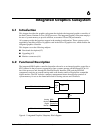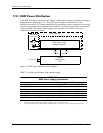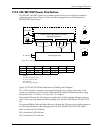
Technical Reference Guide www.hp.com 6-3
Integrated Graphics Subsystem
The total memory allocation is determined by the amount of system memory installed in a
system, along with the BIOS settings, operating system, and system load. Table 6-2 shows the
pre-allocation memory amounts.
System memory that has been pre-allocated is not seen by the operating system, which will
report the total amount of memory installed less the amount of pre-allocated memory.
Systems running Windows Vista or Windows 7 use Protected Audio Video Path (PAVP) to
ensure smooth playback of high-definition video by off-loading video decoding from the
processor to the IGC. Table 6-3 shows the PAVP memory usage for Windows Vista and Windows
7.
NOTES:
[1] Total amount of memory available for graphics as reported by the OS.
[2] Shared System Memory (memory dynamically allocated for graphics use).
Both the “Total Available... and “Shared System...” memory amounts will vary depending on
each system’s memory configuration.
The integrated graphics controller will use, in standard VGA/SVGA modes, pre-allocated
memory as a true dedicated frame buffer. If the system boots with the OS loading the Extreme
Graphics drivers, the pre-allocated memory will then be re-claimed by the drivers and may or
may not be used in the “extended” graphic modes. However, it is important to note that
pre-allocated memory is available only to the integrated graphics controller, not to the OS.
The DVMT function is an enhancement over the Unified Memory Architecture (UMA) of earlier
systems. The DVMT of the Q67 Express selects, during the boot process, the maximum graphics
memory allocation possible according on the amount of system memory installed:
The actual amount of system memory used in the “extended” or “extreme” modes will increase
and decrease dynamically according to the needs of the application. The amount of memory used
solely for graphics (video) may be reported in a message on the screen, depending on the
operating system and/or applications running on the machine.
For viewing the maximum amount of frame buffer memory available go to the MS Windows
Control Panel and select the Display icon, then > Settings > Advanced > Adapter.
Table 6-2.
IGC Memory Allocation with Windows XP
System Memory Installed Pre-allocated DVMT
0.5 GB 32 MB 128 MB
1.0 GB 32 MB 512 MB
1.5 GB 32 MB 768 MB
> 2GB 32 MB 1024 MB
Table 6-3.
IGC Memory Allocation with Windows Vista or Windows 7
System Memory
Installed
Available
System
Memory
Total
Available
Graphics Memory [1]
Shared
System
Memory [2]
1 GB 952 MB 252 MB 124 MB
2 GB 1976 MB 764 MB 636 MB
4 GB 4024 MB 1759 MB 1631 MB
6 GB 6072 MB 1759 MB 1631 MB
8 GB 8120 MB 1759 MB 1631 MB


















